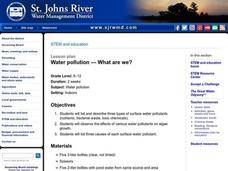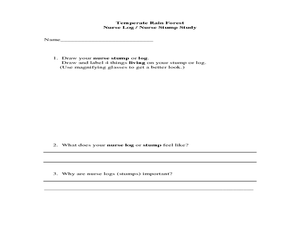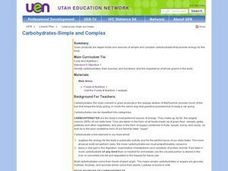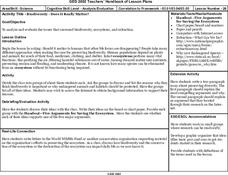Curated OER
Who In the World Is Hungry?
Middle schoolers identify the scope of hunger throughout the world. Using United States data, they discover why hunger is important to the United States and its agriculture. They identify goals of sustainable development and food...
Curated OER
What's on Your Plate?
Students analyze the calorie content of food. In this health science instructional activity, students discuss how excess calories affect our body. They write a healthy meal plan for their family.
Curated OER
Milk and Milk Products: Skills Supplement
Explain the coagulation and coalescence processes associated with milk protein and cheese. List the components of milk and explain how each component is dispersed in the milk. Describe what happens when milk protein is coagulated Discuss...
Curated OER
Plant Parts and their Function
Discover why plants are important to our world. View plant parts and categorize them as stems or buds. Students do a cut and paste of pictures of plants into correct categories. Students also plant a carrot top,and record...
Curated OER
Testing for Life’s Molecules
Want to hear a joke about sodium? Na. Young scientists test various materials to identify if they include protein, starch, and glucose by using the Biuret test, iodine starch test, and Benedict's test respectively. After practicing with...
Kenan Fellows
How Does an Unhealthy Diet Influence our Health and Well-Being?
You are what you eat, or so they say! After surveying family and friends on a week of eating habits, learners analyze the data for patterns. They compare different variables such as fats and cost, fats and calories, or fats and LDLs.
NOAA
Your Own El Nino
Scholars make a model to discover how the force of trade winds over the Pacific Ocean creates an El Niño. Super scientists observe how the severe weather affects life in water and on land.
Biology Junction
Origin of Life
Aristotle explained the idea of spontaneous generation, a concept which lasted almost 2,000 years before scientists proved it wrong. Scholars learn about the history of our understanding of the origins of life. They read examples of...
Curated OER
Vitamin C and Protein Analysis
Young scholars analyze various beverages to determine vitamin C content. Students research diseases resulting from vitamin C deficiencies and identify countries most affected.
Curated OER
Quick Breads (Banana Muffins)
Students review what they know about quick breads and bananas. In this art lesson, students discover two different recipes for Banana Muffins off of the computer. Students prepare a recipe for Bananas Muffins carefully and clean up their...
Curated OER
What Are We?
Learners list and describe three types of surface water pollutants. They observe the effects of various water pollutants on algae growth. Three causes of each surface water pollutant is listed.
Curated OER
Temperate Forest : Pacific Spirit Field Trip
Students examine nurse logs with hand lenses and identify animals. In this ecosystem lesson, students gain understanding of the rainforest by studying nurse logs. Students become familiar with vocabulary through their study...
Curated OER
Soil, Designer Soil: From Rainforests to the Prairie
Students explore the role and importance of soil in the ecosystem. For this Science and Social Studies lesson, students complete an experiment using various kinds of soil and clay and then examine how soil has a direct impact on...
Curated OER
The Open Ocean, What is it and How Does it Change?
Students investigate the ocean environment. In this ocean lesson plan, students discover the physical properties of the ocean. Over two days, students work in small groups investigating ocean maps and creating water currents.
Curated OER
Hydroponics
Students discuss the concept of hydroponics. They create and run their own hydroponics system. They record and analyze the data they collect.
Curated OER
Carbohydrates - Simple and Complex
Young scholars examine simple and complex carbohydrates. They take notes and complete a worksheet. They also research cookbooks and find recipes which shows the simple and complex carbohydrate groups.
Curated OER
Clay Hill Animal Sampling
Students create animal print casts from molds in the classroom. They use the cast patterns to identify animal prints on a field trip in which they locate animal tracks, identify the location with GPS and create field casts of the...
Curated OER
Biodiversity - Does It Really Matter?
Students examine biodiversity, ecosystems, and extinction. They are divided into groups to discuss why they think biodiversity is important.
Curated OER
Growing Stages of a Rice Plant
Third graders make a chart to compare the growth of a wheat plant verses the growth of a rice plant. In this planting lesson plan, 3rd graders study the growth of the 2 plants and show the similarities and differences.
Curated OER
What Are We?
Students describe different types of water pollutants. They complete experiments in which they observe the affects of water pollution on algae. They also brainstorm and list three causes of each water pollutant.
Curated OER
DID YOU HELP CREATE THIS
Students examine whether their actions are positively or negatively affecting organisms and their habitats. They choose an animal to study then create a multimedia presentation including charts and graphs of data logger information and...
Curated OER
Density Stratification and Ocean Circulation
Students examine how circulation currents of the ocean. They use a tub of hot and cold water to demonstrate the currents. They discover how salinity and temperature of water affect its movement.
Other
British Nutrition Foundation: Food a Fact of Life (11 16 Years): Micronutrients
This lengthy PowerPoint slideshow examines micronutrients which are nutrients needed in small amounts. It looks at water- and fat-soluble vitamins and at minerals, their sources, their functions, and the impact of deficiencies of these...
BBC
Bbc: Gcse Bitesize: Animal Organization Digestion
The major nutrients required for a healthy diet are carbohydrates, proteins, and lipids. The digestive system breaks down large molecules of food, which are then absorbed into the bloodstream. After reading, try the quiz.























